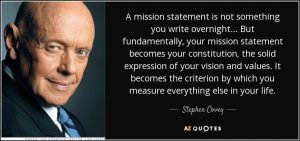Changing and Aligning of Vision and Mission Statements
A mission statement describes the overall purpose of an organization. A mission statement should be brief and answer key questions about the business of organization. Questions such as what are the basic objectives of the firm? Who are the target audience? These points should be mentioned in the mission statement. A mission statement describes what an organization hopes to achieve.
Vision Statements
Vision statements mention aspirations of the organization; they lay out the most important primary goals for a company. A vision statement is a company’s road map, indicating both what the company wants to become and guiding transformational initiatives by setting a defined direction for the company’s growth.
The top management in organizations spend a lot of time drafting, designing words, and redrafting vision statements, mission statements, values statements, goals and objectives so on and forth.
And somewhere in the course of the organization’s journey, many of its actions don’t align with the well drafted vision and mission statements. Also, in the absence of a well drafted, or a poorly written vision and mission statements organizations lose good number of opportunities in attracting and engaging talented human resource, building organizational culture, and increasing productivity while leveraging all resources to successfully implement a strategic plan.
Organizational success is often linked to inspiring vision, clear mission, and strong values. But without employee buy-in, these concepts are worthless. Employee engagement is essential to an organization’s success, and alignment is arguably even more important.
 Do you know that the founders of great and stable organizations like Hewlett-Packard, 3M, and Johnson & Johnson did not have a vision statement when they started out? They began with a set of strong personal core values and a relentless drive for progress and yet had an amazing ability to translate these into concrete mechanisms. 3M Corporation always had a sense of its core values in place such as support innovation, protecting the creative individual, solving problems in a way that makes people’s lives better. These core values gave it its soul. But what really set 3M apart was the ability of its leadership over the years to create mechanisms that bring these principles to life and translate them into action. For example, 3M allows scientists to spend 15 percent of their time working on whatever interests them, requires divisions to generate 30 percent of their revenues from new products introduced in the past four years, has an active internal venture capital fund to support promising new ventures, preserves a dual career track to encourage innovators to remain innovators rather than become managers, grants prestigious awards for innovations and entrepreneurial success, and so on.
Do you know that the founders of great and stable organizations like Hewlett-Packard, 3M, and Johnson & Johnson did not have a vision statement when they started out? They began with a set of strong personal core values and a relentless drive for progress and yet had an amazing ability to translate these into concrete mechanisms. 3M Corporation always had a sense of its core values in place such as support innovation, protecting the creative individual, solving problems in a way that makes people’s lives better. These core values gave it its soul. But what really set 3M apart was the ability of its leadership over the years to create mechanisms that bring these principles to life and translate them into action. For example, 3M allows scientists to spend 15 percent of their time working on whatever interests them, requires divisions to generate 30 percent of their revenues from new products introduced in the past four years, has an active internal venture capital fund to support promising new ventures, preserves a dual career track to encourage innovators to remain innovators rather than become managers, grants prestigious awards for innovations and entrepreneurial success, and so on.
Change is constant and needs to be taken into account as it is an essential component of strategic planning. So many changes take place in organizations. Change in manpower, change in business processes, change in product portfolio, change in infrastructure so and forth. This involves moving the organization or program forward or backward to create or change something. Some plans are created out of the need for the organization to move in a certain direction, and other plans develop organically. At such times, mission and vision statements need little tweaking, rephrasing, redesigning – little change and they are important to help communicate the goals of the plan to employees and the public.
Often companies modify their vision to fit the current environment; the changes internally or externally require a revision of in its mission or vision. To identify misalignments organizations require looking around internally as well as externally, talking to people, getting inputs, and finding out whether their core values align with their business philosophies. The misalignments arise because years of ad hoc policies and practices which are incomprehensible with the organization’s underlying values. When organizations don’t mean what they have signed off as vision and mission, at some point, the employees in the organization begin to grumble about the organization’s complex sign-off process, recognizing its inconsistency with the notion of respect and trust for the individual. The first task for leaders, then, is to create an environment and a process that facilitate people to safely identify and eliminate these misalignments.
Let’s take a look at Nestlé’s vision: “to be a leading, competitive, nutrition, health and Wellness Company delivering improved shareholder value by being a preferred corporate citizen preferred employer preferred supplier selling preferred products.”
Nestlé web site includes both a “mission statement” and a “vision and values” statement. Although the company is known for Nestlé Crunch chocolate bars and other snack foods, these statements emphasize nutrition, wellness, and good corporate citizenship.
The Swiss company’s “vision and values” statement is quoted above. Its “mission statement” is: “Nestlé is…the world’s leading nutrition, health and wellness company. Our mission of ‘Good Food, Good Life’ is to provide consumers with the best tasting, most nutritious choices in a wide range of food and beverage categories and eating occasions, from morning to night.”
These statements mirror the company’s long-term business strategy. In keeping with its claimed promise to nutrition, Nestlé has invested in scientific research on nutritional aspects of the kinds of products it sells. For example, it has studied the effects of chocolate on metabolism and gut bacteria. The Economist describes this as a potentially risky strategy; by investing in research and development, the company is “playing a long game,” in contrast to the short-term strategies of some of its competitors.
Nestlé has also made an effort to practice “corporate citizenship.” It has been involved in a number of efforts to promote good agricultural and environmental practices, such as the World Cocoa Foundation, which is “committed to creating a sustainable cocoa economy by putting farmers first – promoting agricultural and environmental stewardship, and strengthening development in cocoa-growing communities.”
This article emphasizes not only being consistent with vision and mission but true alignment.
In describing the alignment process, it is assumed that an organization’s core values are already clearly defined. It is important that people must be predisposed to holding them, and it is important to attract and then retain these people. Every organization has to wrestle with a niggling question: what should change and what should never change? Can policies or strategies change at a particular time? Can its core value change? Can cultural values change? Remember, undying core values should never change. But, operating practices and cultural norms should never stop changing. Because business environmental changes are constant and organization needs to change according to the environmental changes.
It’s always a good practice to review the vision and mission because in the organization’s lifecycle lot of changes takes place. The sector in which it operates changes economically, socially, or politically; if the top management in organization such as the CEO, VP or General Manager changes their philosophy and ideas change; if the product or service line has become obsolete due to regulation, or replacement for example cigarettes, or full service gas stations there is an immediate change in the business; sometimes the current product version is being replaced by another (iPods, for example being included into iPhones); if an organization acquires another firm it needs to change its entire philosophy. As an organization evolves, to explain its foundation its vision and mission need the changes.














































